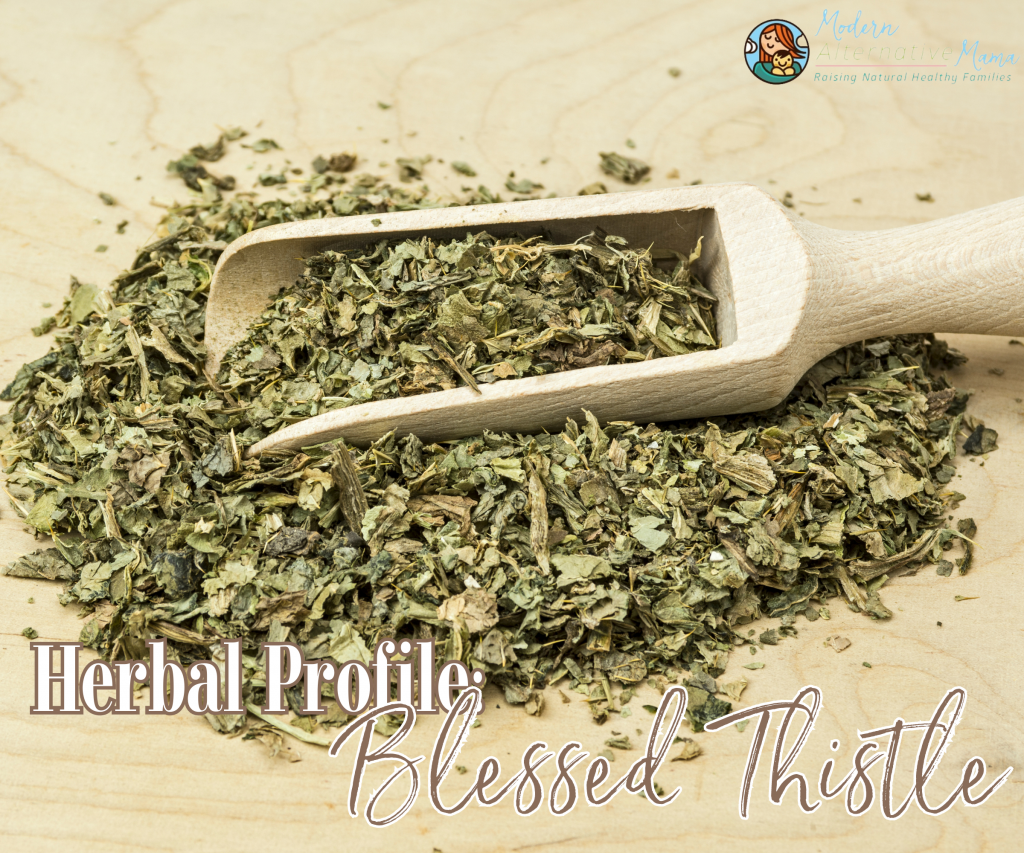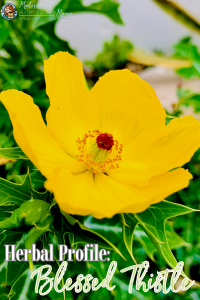What is Blessed Thistle
Blessed thistle (not to be confused with its close cousin, milk thistle), sometimes called lady’s thistle, holy thistle, or its scientific name Cnicus benedictus, is a part of the Compositae family. Blessed thistle is native to the Mediterranean and western Asia and can grow upwards of one foot tall. Blessed thistle can be identified by its spiked, fine-haired leaves that sprout yellow or purple flowers (1).
Health Benefits of Blessed Thistle
Blessed thistle’s seeds, roots, leaves, stems, and flowers can be used for an array of medicinal benefits including, but not limited to:
Antioxidant Properties
Antioxidants can help fight damage from harmful free radicals. The buildup of free radicals has been linked to chronic diseases, such as cancer and heart disease (2). Plant compounds in blessed thistle, like polyphenol, phenolic, and flavonoid content, have demonstrated significant antioxidant activity and protection from free radical damage (3,4). One study demonstrated how the antioxidant properties of blessed thistle influenced anti-inflammatory properties (5). It is important to note the bioaccessibility effect of processed treatments, like freezing and boiling, on the herb’s antioxidant properties (6).
Antibacterial Properties
An antibacterial property is when a substance, or in this case, an herb, can destroy or suppress the growth and reproduction of bacteria (7). One study tested two antibiotics and the ethanolic extract of blessed thistle’s leaves, finding blessed thistle to have significant antibacterial activity against E. coli (8). Another study documented blessed thistle’s antibacterial properties when it displayed inhibitory effects against Helicobacter pylori (H. pylori) infection (9). Additionally, it is important to note that some studies have documented greater antibacterial benefits in mature blessed thistle flowers versus immature flowers (10).
Anti-Inflammatory Properties
Although inflammation is a natural bodily response, chronic inflammation can lead to detrimental health effects. Chronic inflammation has been linked with many diseases, such as type 2 diabetes, asthma, and certain cancers (11). One animal study found that blessed thistle’s anti-inflammatory properties inhibited carrageenin foot edema in 72% of rat subjects (12). Another animal study found that the dietary inclusion of blessed thistle extract can modulate inflammation and stress, and immune-related genes in Nile tilapia fish (13).
Pain-Relieving Properties
As of 2016, an estimated 20.4% of U.S. adults (50.0 million) had chronic pain, and 8.0% of U.S. adults (19.6 million) had high-impact chronic pain (14). Aside from blessed thistle’s anti-inflammatory properties, studies have also found it beneficial for nociceptive and inflammatory pain (15). Some studies have even mentioned using blessed thistles for stomach pain, menstrual pain, and menstrual stimulation (16,17,18).
Wound-Healing Properties
Due to its antioxidant, antimicrobial, and anti-inflammatory properties, blessed thistle can provide exceptional wound-healing properties. Wound-healing properties are the complex and dynamic process of restoring tissue structure in damaged tissue as closely as possible to its normal state (19). Thankfully, herbal books note blessed thistle’s wound-healing benefits (20). One study found a combination of blessed thistle powder and vaseline to have better wound-healing properties than Baneocin ointment after 14 days of use (21).
May Support Healthy Digestion
The digestion process breaks down food into smaller components that can be absorbed into the bloodstream and turned into nutrition (22). When your foods aren’t digested properly, you may experience digestive troubles like heartburn. Thankfully, blessed thistle has been documented to enhance digestion and increase bile secretion (23). For example, in animal studies, when researchers investigated rat gastric juice, major components of blessed thistle, like arctiin, rapidly transformed to arctigenin, followed by conversion to the major metabolite (24).
May Increase Breastmilk Supply
Lactation occurs when hormonal changes signal the mammary glands to make milk in preparation for a baby (25). Thankfully, blessed thistle (not to be confused with milk thistle) is also a popularly recommended herbal galactagogue (26). Although many mainstream sources claim no evidence to prove this (27), tradition says something different. Even mainstream sources acknowledge the use of blessed thistle in folk medicine, traditionally passed down knowledge (28).
Unfortunately, researchers haven’t studied this herb much, so these claims can’t be proven. The only study I could find was very limited. It included three breastfeeding mothers who used a combination of fenugreek and blessed thistle. Two of the three women found the combination successful, and one was unsure (29). Since an herbal combination was used, we cannot isolate which herbs were successful, especially when fenugreek is known to increase milk supply.
Nonetheless, the blessed thistle’s remarkably safe nature wouldn’t harm mom or baby if used, especially considering its many other health benefits. With that said, I sure hope they further analyze the lactation benefits of blessed thistle as science continues to advance.
Anticancer Properties
Statistics say that 158.3 of every 100,000 individuals will die from cancer (30), but what if they didn’t have to? Blessed thistle has a plant lignan known as arctigenin that exhibits cytotoxic activity, which can kill cancer cells (31,32). Additionally, a medical journal concluded that blessed thistle is one of the most promising medicinal plants for cancer thanks to its inhibitory and toxic effects on cancer cells (33).
Safety Concerns
Mainstream sources caution against the use of blessed thistles. Although milk thistle is commonly consumed in foods, they claim there isn’t enough reliable information to know if it’s safe to use as a medicine or what the side effects might be. The mainstream also cautions against usage while pregnant and topical usage (34).
Contrarily, milk thistle has documented benefits for topical use and medical dosages. One herbal source cautions in excessive doses, blessed thistle may cause vomiting (35). Another herbal source recommendation is to avoid blessed thistle while pregnant or if you have hypothyroidism or Grave’s disease (36).
Since there is mixed information on the safety of blessed thistle while pregnant, I recommend independently researching the topic and drawing your own conclusion before choosing if you’re comfortable taking this herb. I will note there is no data to prove it is unsafe to use while pregnant; I searched for studies of usage while pregnant, and there were none.
How to Use Blessed Thistle
You can find blessed thistle in dried bulk, pills, powders, extracts, or tinctures. Tinctures always contain the most concentrated amount of herbs. Teas and soups are also options, especially when following Ayurvedic medicine recipes. If you’re a DIY person, some great starter recipes are:
- 5 Herbs to Increase Milk Supply
- Do Galactagogues Really Work?
- How to Naturally Boost Your Milk Supply (+ Mother’s Milk Tea Recipe)
Follow the recommendations of any supplement; some of my recommendations include:
- Earthley’s Mama’s Magic Milk Boost is an herbal tincture created to help increase milk supply with all-natural ingredients. This product is high in vitamins and minerals to nourish the body, but it also contains herbs to soothe baby’s tummy. This tincture is made with the highest-quality ingredients and supports both mom and baby on their breastfeeding journey.
Disclaimer: This post is not intended as medical advice. These statements have not been evaluated by the FDA, and nothing in this post is intended to diagnose, treat, or cure anything. If you have questions, please do your own research or seek advice from a health professional.



